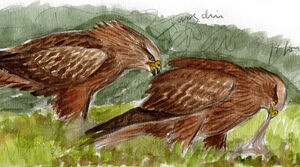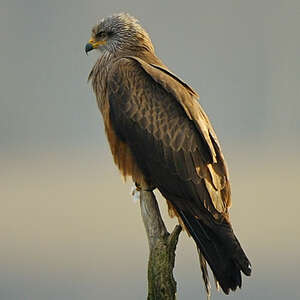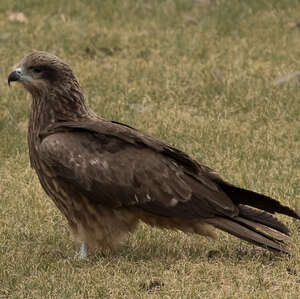Black Kite
Milvus migrans - Milan noir
Identification
As I did for the 'Royal Kite', I will describe the Black Kite in comparison with its congenrica. Indeed, when posed, they can be confused, but thankfully not in flight. The silhouette of the Black Kite is different. It is smaller, less slender and its tail barely exceeds the points of its closed wings. It is generally darker but the pattern of its feathers is almost the same. Let's look at the adult. Seen from the front, one notices a darkly streaked gray head, cinnamon brown underside and a grayish tail barred with dark. It is in bright light, in full sunlight that it can evoke the 'Royal Kite', the gray of the head can appear quite ash and the red of the underside brighter. On the other hand, seen from the back, there is no problem. The plumage of the upper parts is of a solid brown, with the edges bordered in beige forming a pale zone. Above all, the tail is brownish, never reddish in appearance. The beak is black, the iris pale yellow, the cere and legs yellow. The juvenile is typical with its brown plumage marked with chamois (mottled/edged above, striped below), its head streaked with chamois with a dark area around the eye and pale yellow waxy. The immature plumages are closer to that of the adult. In flight, the silhouette is an important criterion. The Black Kite also has bent wings, slightly drooping in gliding flight, but shorter than those of the 'Royal Kite'. The tail is shorter and less concave. Spread out, it is triangular. Seen from above, the bird is brown with lighter coverings. From below, the feather pattern is the same as that of the 'Royal Kite', but darker and much less contrasty. The white spots on the wings in particular stand out less. But it's still the tail that remains the determining criterion. 7 subspecies are described which present notable variations compared to the description above, particularly the ssp lineatus.I won't mention it here but the iconography will make reference to it. Oiseaux.net already treats the African ssp. aegyptius, the Black Kite, as a good species with 2 ssp.
Subspecific information 5 subspecies
- Milvus migrans migrans (s and c Europe to n Africa and sc Asia)
- Milvus migrans lineatus (Siberia to Japan, Indochina and India)
- Milvus migrans govinda (Pakistan and India to Malay Pen. and s Indochina)
- Milvus migrans formosanus (Taiwan and Hainan. off se China.)
- Milvus migrans affinis (Lesser Sundas to Australia)
Foreign names
- Milan noir,
- Milano negro,
- milhafre-preto,
- Schwarzmilan,
- barna kánya,
- Zwarte Wouw,
- Nibbio bruno,
- brun glada,
- Svartglente,
- haja tmavá,
- luňák hnědý,
- Sort Glente,
- haarahaukka,
- Swartwou,
- milà negre,
- Vatnagleða,
- kania czarna,
- melnā klīja,
- črni škarnik,
- Чёрный коршун,
- Elang paria,
- トビ,
- 黑鸢,
- เหยี่ยวดำ,
- 黑鳶,
Voice song and call
Habitat
The Black Kite is an ubiquitous species in the territories it occupies, present nearly everywhere in plains and in mid-mountains.
Behaviour character trait
The most notable character trait of this species is its gregariousness, which is more pronounced than that of its congener, the Black Kite.
It can nest in loose colonies. As soon as the young birds become independent and the adults have fulfilled their parental duties, the birds gather together, particularly at the edge of open waters where they will sleep at night. Like the Black Kite, the Black Kite is drawn to sources of food, particularly in our waste disposal sites where edible waste attracts masses of scavengers. The time of haymaking is also a blessed time. The kites are attracted to the mowing of the meadows and the resources associated with it. In Europe, Black Kites dominate in number over the Common Kite. In countries like India, they frequent public dumps near urban areas in the hundreds and even thousands. European birds are strictly migratory. They spend the winter south of the Sahara. Tens of thousands pass through Gibraltar. Reaching their territories in mid-March on average, they are somewhat like swallows: heralds of spring in the countryside. They will stay for around four months, long enough to reproduce, then from mid-July the return journey will begin and will peak in August. By September, only a few stragglers will remain.Flight
Its flight recalls that of the royal kite. The wings being shorter, the beats are a bit faster but we recognize the slightly drooping, typical kite-bends.
It also uses gliding flight a lot, every time possible, both in search of food and in migration. The shape and color of the tail allows to make sure of the glider's identity. The flight of the Black Kite, both beat and gliding, is very different from that of the buzzard which beats its wings in a jerkly manner, without the suppleness of the kite, and which glides wings slightly raised.Dietfeeding habits
The Black Kite is a very predatory bird and even detritophagic when it frequents dumps. It often behaves as a commensal of Man, knowing that the table is often laid for it, particularly in developing countries (various dumps, slaughterhouse or killing walls, fishing spots and even simple piles of domestic waste).
It looks for the corpses of animals where they are to be found. It follows roads to recover animals killed by vehicles, mostly vertebrates but also large insects. Likewise, it soars above rivers and ponds for dead fish floating on the surface. It often flies in groups above pastures being reaped, for animals killed or wounded by the blade, but also for all the little wildlife bent down to the ground. The turning over of agricultural parcels attracts it too since it makes accessible all the terrestrial wildlife, particularly the field mice. In the beautiful season, it knows how to take advantage of the massive swarms of insects such as winged ants or imagos of aquatic larvae (pearls, mayflies, odonates...) that it grabs in its talons and carries in its beak.Reproduction nesting
The breeding period varies greatly depending on the subspecies and the region. In Europe, it ranges from April to June, although current climate changes tend to anticipate it.
The Black Kite is monogamous. Depending on the conditions of the environment, it nests either in isolation or in loose colonies, which is often the case in a body of water. After some aerial parades, the couple is busy with nesting. The nesting site is often at the edge of a forest for easy access. When the terrain has significant relief, the area can be on a wooded slope. It is built high in a large, leafy or coniferous tree, in a main fork or on a large lateral branch. This area does not have the amplitude of the king's. It is more compact, thicker and systematically includes visual materials such as paper, plastic, fabric, leathers..., which makes it typical. An old area can be renovated and reused. The female lays 2 or 3 eggs which she incubates alone for just over a month. She does not leave the nest, with the male taking care of the supplies and the female during incubation and the family during the stay in the nest, which is about a month and a half. The juveniles will remain dependent for about fifteen days after the flight. Then, group behavior sets in and the birds will regroup in strategic places where they will prepare for the early migration of this species.Geographic range
The Black Kite's nesting area is much larger than the royal one. It covers the Eurasian continent except for the British Isles, Scandinavia, Northern Siberia and the extreme east of Russia. The main areas are Europe, NW Africa and SW Asia (ssp type migrans), eastern Pakistan, the Indian continent and Ceylon, south China, Indochina and the Malay peninsula (ssp govinda), Mongolia, northern China and Japan (ssp lineatus), and finally Australia (ssp affinis). Migrans and lineatus are migratory and they winter in the south, south of the Sahara for the former, in the south of India and SE Asia for the latter.
Threats - protection
IUCN conservation status
concern
in the Wild
threatened
evaluated
As was the case with the Red Kite, there was a decline in European populations of the Black Kite at the end of the 20th century, for the same reasons, first and foremost the consumption of prey poisoned or contaminated by various agricultural pesticides. Since then, the situation has improved. Surveys from Gibraltar show an increase in numbers of migrating birds, which reflects likely a switch to more rational, less polluting agriculture of soils and waters. At the same time, new threats can appear like the large-scale development of wind farms that create obstacles to birds becoming mobile like the kites. We must thus remain vigilant. Nevertheless, the Black Kite remains the most common raptor in many countries, in particular in Japan, India and sub-Saharan Africa. It is currently considered to not be at risk globally. It is helped by its commensalism with humans.
Sources of information
- IOC World Bird List (v15.1), Gill, F and D Donsker (Eds). 2025-12-07.
- Les rapaces diurnes et nocturnes d'Europe, M. Cuisin, P. Geroudet
- Birds of the World, The Cornell Lab of Ornithology
- xeno-canto, Sharing bird sounds from around the world,
Other sources of interest
 Specification sheet created on
12/07/2023 by Jean François
Specification sheet created on
12/07/2023 by Jean FrançoisTranslation by AI Oiseaux.net
© 1996-2026 Oiseaux.net
- Accipitriformes
- Aegotheliformes
- Anseriformes
- Apodiformes
- Apterygiformes
- Bucerotiformes
- Caprimulgiformes
- Cariamiformes
- Casuariiformes
- Charadriiformes
- Ciconiiformes
- Coliiformes
- Columbiformes
- Coraciiformes
- Cuculiformes
- Eurypygiformes
- Falconiformes
- Galliformes
- Gaviiformes
- Gruiformes
- Leptosomiformes
- Mesitornithiformes
- Musophagiformes
- Nyctibiiformes
- Opisthocomiformes
- Otidiformes
- Passeriformes
- Pelecaniformes
- Phaethontiformes
- Phoenicopteriformes
- Piciformes
- Podargiformes
- Podicipediformes
- Procellariiformes
- Psittaciformes
- Pterocliformes
- Rheiformes
- Sphenisciformes
- Steatornithiformes
- Strigiformes
- Struthioniformes
- Suliformes
- Tinamiformes
- Trogoniformes


































